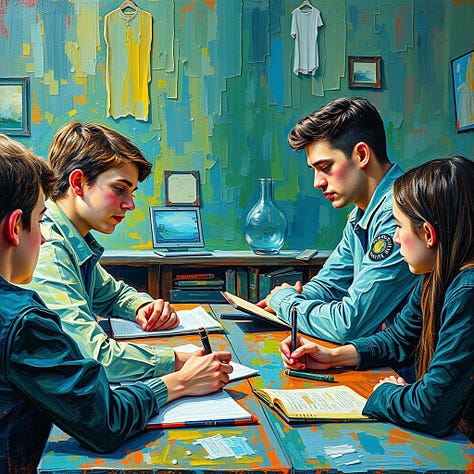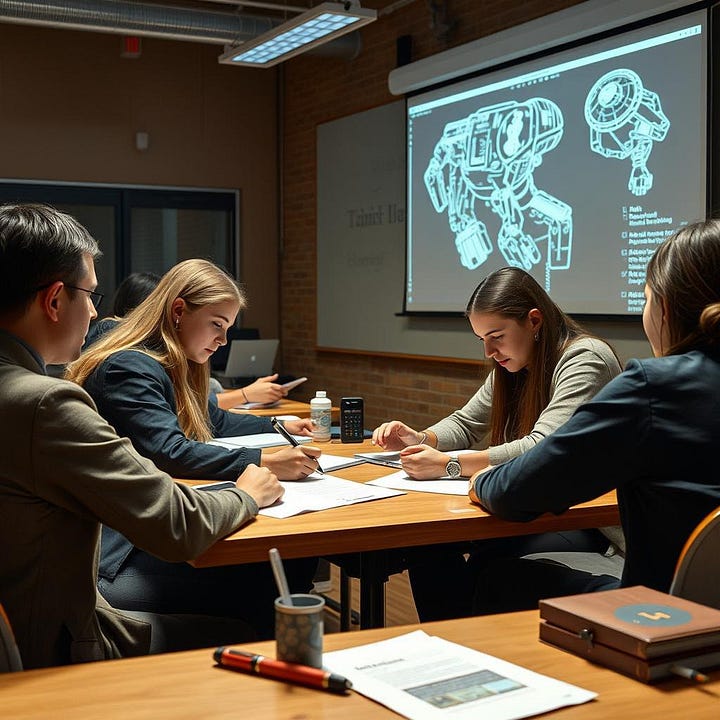Teaching Writing in the Age of AI:
A Guide for the Educator Who Refuses to Stop Teaching
In this strange moment of transition, between analog thought and digital acceleration, writing itself is being redefined. And not by poets or professors, but by lines of code and pattern recognition engines that never sleep. If that makes you uneasy, it should. But it should also stir something deeper in you, a challenge, maybe even a calling. Because the real threat isn’t that AI will replace writing. It’s that we, as educators, might let it.
What if we taught writing not as an act of mechanical output, but as a framework for thought, a mirror for the mind, and a way for navigating truth in an increasingly unstable world? What if, instead of banning the machine, we taught students how to write with it ethically, reflectively, and above all, humanely?
This isn’t just a policy adjustment. It’s a philosophical realignment.
Step 1: Freewriting Comes First — Because Thought Should Have a Pulse
Before we invite the machine into the room, we must first make space for the self. That means we begin not with a prompt and not with a chatbot, but with a blank page and a few moments of solitude. This is not some romantic return to pre-digital purity; it’s a deliberate pedagogical choice to center original thought before the tools get involved.
Have students sit and write, just for a few minutes at least. No instructions, no AI, no guidelines except: “Write what you think about the assignment. Or don’t. Just write.” It doesn’t need to follow form. It doesn’t need to answer the question. It only needs to be theirs. A raw, unfiltered sketch of voice, experience, confusion, instinct, memory. This is where writing begins, not in clarity, but in contact and sometimes chaos.
Too often we mistake writing for answering. But thought doesn’t come fully formed. It emerges through pressure and pause. The freewrite is that first pressure point, the first struggle. And it is essential. Because once AI enters the picture, the temptation to borrow, blend, and blur can easily overtake the fragile pulse of a student's own voice. Freewriting protects that voice. It marks a line in the sand: ‘This is me. Before the assist. Before the edits. Before the algorithm.’
It’s not about banning tools. It’s about reminding students they still have something to say on their own. That writing is not just output. It’s evidence that they and their very ideas exist, that they are capable of drawing a line from thought to language without automation in the middle.
In a world increasingly written by machines, the first rule of good writing may be this: begin by remembering you are not one.
Step 2: Only Now Do We Invite the Machine In
Once the student has made contact with their own mind, once their hand has moved across the page or fingers across the keys without artificial suggestion, we open the door to the machine. But not as oracle. Not as muse. And certainly not as author. We bring in AI only now, and only as a research assistant: a tool that can generate options, surface possibilities, define boundaries, but never dictate the core.
At this stage, students are encouraged to ask questions, not to be fed answers, but to discover the shape of the discourse, their own. They might ask ChatGPT to define a term they used in their freewrite, or to present counterarguments they hadn’t considered. They might prompt Gemini to list examples from history, or Claude to play devil’s advocate against the position they thought they held. The goal isn’t to fill a blank page; it’s to deepen the terrain already mapped.
But here's the key: nothing AI provides should be taken at face value. If the student isn’t surprised, confused, or challenged by the response, they’re likely skating across the surface. Encourage them to ask deeper questions, more precise questions, questions that the model struggles to answer cleanly. Because that friction, that uncertainty, is where actual thought begins.
This is not just about improving output. It’s about cultivating intellectual tension. And that tension is where we find epistemological clarity, not from the answers themselves, but from the awareness of what we are asking, and why.
Students should also completely document the interaction with screenshots, transcripts, prompt threads, and quick summaries. This isn’t simply to surveil their process, but to make it visible, to transform invisible prompting into a transparent, reviewable part of the writing journey, the whole process. What was the question? What did the AI say? How did the student respond to it. Did they accept, reject, revise, reframe it?
Then comes the reflection: ‘What did I learn? What surprised me? What felt off?’ These are the questions we want students to wrestle with because these are the questions that build thinkers, not just writers. This isn’t just prompting practice. It’s epistemology 101. It’s the student stepping back and asking not just “What did the AI say?” but “What does that say about what I know, what I value, and what I believe?”
At its best, AI doesn't flatten inquiry; it multiplies it. But only if the student remains in the driver’s seat, steering through complexity, not just coasting in the lane the model suggests.
We don’t ban the machine. We just make sure it’s arriving second, not first. Always following thought, not replacing it. Because once students realize that asking good questions is more powerful than getting fast answers, they’ve already begun to reclaim their agency in an AI world.
Step 3: Drafting: The Line Between Thought and Tool
With ideas now stirred up, both human-born and machine-triggered, the drafting begins. This is the stage where boundaries blur, and that blurring is not a flaw. It is the very terrain students must learn to navigate. Because this is where authorship becomes a negotiation between instinct and influence, a discussion between voice and suggestion, and a conversation between structure and spontaneity.
Students can and should use AI here, but not as ghostwriter. As collaborator. They might ask for help building an outline, testing a different structure, or transitioning between sections. They may use the model to rephrase a sentence they’re struggling with or to try out alternate versions of ideas. These aren’t shortcuts. They’re scaffolds. But what matters most is this: every sentence that survives into the final draft must be owned and cited where appropriate.
Owned means molded, by human hands, by human thought. It means tested for truth, clarity, and relevance. It means the student has made a decision: Yes, this stays. Because it works. And if it came from the model? Fine. I can cite it. But only if it’s understood, adapted well, and accounted for.
That’s why we ask them to cite their work: what was AI-assisted and what wasn’t. Not as a ‘gotcha’, not for punishment, but for transparency over performance. It’s okay if a student asked the model to help reword a complex thought. But do they understand the change? Did they keep it as-is? Did they revise it again afterward? Why?
This is the key: the goal isn’t purity; it’s awareness. Writing in this era isn’t about proving you didn’t use a tool. It’s about showing that you used it well. That you remained the writer, the shaper, the thinker in the room. That you didn’t let the algorithm take over your voice, even when it offered you one.
The danger of AI in drafting isn’t that it gives students ideas. It’s that it can flatten the tension that real writing demands. The risk is not that it helps too much, but that it helps too easily. So, we train students to resist that ease, not by avoiding the tools, but by interrogating what they produce.
If the freewrite was a declaration of voice, then the draft is a field test of integrity. Not perfection, not polish. Just presence. Are you still here in your own words? Can we still hear you?
That’s what matters.
Step 4: Revise Like a Human (with Help from a Machine)
Now, the machine may enter the editing room, but only as a guest. The student remains in charge. At this point in the process, the draft is on the page. The bones are there. And this is where the real work begins: shaping, shifting, reconsidering, removing, re-committing. This is where writing becomes recursive, alive. And yes, the machine can help. But it must not be allowed to overwrite what the student fought so hard to build.
AI shines in revision. It can offer tone checks, highlight awkward transitions, suggest clearer phrasing, or offer new ways to open or conclude a paragraph. The feedback is fast, confident, and often sharp. But that’s exactly what makes it dangerous if left unchecked. Because clarity at all costs can dull the edge of a writer’s voice. And ease, when overindulged, can feel like mastery, when it is far from it.
So, we ask students to compare. What did the model suggest? What would, what did a peer say? What would you say, if you stepped away and returned tomorrow? Revision becomes a dialogue, not just between writer and reader, but between writer and assistant, between the student and the machine. But the writer must always have the last word.
That’s why we ask them to reflect, not just once at the end, but throughout. After every major change, they should pause: ‘Did this bring me closer to what I meant? Or did it just make it smoother, safer, more sterile?’ Because clarity is important, but so is texture. So is friction. So is the human fingerprint that AI will always lack.
The danger at this stage isn’t plagiarism; it’s erosion. The subtle smoothing out of thought. The surrender of uncertainty. But if students are taught to resist the urge to defer entirely to the tool, they learn something far more valuable than grammar: they learn judgment. They learn how to be in conversation with feedback, without being replaced by it.
This is the paradox of revision in the age of AI: the more powerful the tool becomes, the more fiercely we must guard the writer’s place at the table.
Step 5: Reflection Is the Real Assessment
The final submission isn’t just a polished essay. That’s old thinking. In this new paradigm, the writing itself is only part of the deliverable. What matters just as much, perhaps more, is the reflection that travels with it.
We ask students: ‘What parts of this did you use AI for, and why? What surprised you? What challenged you? Would your paper have been better, or worse, without it? Did you grow as a thinker, or just get faster at outsourcing?’
These aren’t soft questions. They are, in fact, the whole point. Because in a world where automation accelerates everything from research, drafting, revision, even the illusion of insight, the only real safeguard we have is conscious engagement. Awareness. Metacognition. The ability to stop and say: I see what the tool is doing, and I see what I am doing.
Reflection can transform the assignment from a simple task to transformation. It lets students see writing not as a static submission, but as a layered process of decisions, some theirs, and some not. And, it teaches them that how they write matters just as much as what they write.
When students articulate their process, when they map the territory between an idea and an output, they develop a writer’s discipline. And more than that, they build the muscle of self-regulated thinking. That’s not just academic development. That’s life readiness in a machine-assisted world.
So yes, we want them to submit a good paper. But we also want them to walk away with something bigger: the ability to trace their thinking, to defend their choices, and to claim their authorship, even when they’ve had help.
In the age of AI, that’s the new literacy. And we’d be unwise not to teach it.
The Rubric Must Evolve: It Must Reflect the World We’re In
We can’t keep using rubrics designed for solo-authored prose in a world where writing is often hybrid, layered, and partially machine-assisted. The old frameworks were built to evaluate product: Is it coherent? Is it grammatically correct? Does it follow the format? But that kind of grading, while still useful, can’t touch what really matters now.
What we need are rubrics that capture process, not just polish. We need categories that reward thinking, decision-making, ethical navigation, and the students’ ability to reflect honestly on how they used the tools available to them. We don’t measure originality by trying to detect whether a paragraph was written by AI. We measure it by detecting ownership. Did the student understand what they were saying? Did they build something? Did they shape, revise, and refine with intention? Is it them or the model?
This means we start grading things many have overlooked before: the quality of their questions, the depth of their revision choices, the clarity of their reflection, the transparency of their method. In short, we teach students not just how to write, but how to talk about their writing and thus their thinking. Not just how to submit a paper, but how to build and own their process.
And yes, of course we still assess the final product. A polished, clear, compelling piece of writing still matters. But we assess it in context. Because in this new era, the process doesn’t just inform the product; it reveals the character of the writer behind it.
When students begin to understand that their thinking is part of the grade, that how they arrived matters just as much as where they ended up, we shift the center of gravity. We stop grading artifacts. We start assessing agency.
That’s where the future of writing lives: not just in how well students can mimic structure, but in how well they can navigate tools without surrendering authorship to them. Not just in whether they use AI, but in how they remain human while doing it.
What Are We Really Teaching?
Let’s be honest: we’re not here to teach five-paragraph essays. We’re not here to produce tidy academic products that hit every rubric box and disappear into the void. We’re here to teach humans. That means teaching how to think, how to express, how to interrogate an idea, how to build an argument, how to shift perspective, and now, how to collaborate with machines without becoming one.
This new AI-supported writing process isn’t a threat to education. It’s an invitation to redefine it. It’s an opportunity to stop treating writing as a mechanical task and start treating it as what it truly is: a living, recursive, dynamic cognitive ecosystem. One that requires voice, context, reflection, judgment, and the courage to revise, not just a paper, but the self that wrote it.
If AI can draft, revise, and polish with a keystroke, then what matters now is not whether a student can write without help, but whether they can stay awake in the process, whether they can stay conscious, critical, and still in possession of their agency. Behind every prompt input must still be a person. A student. A thinker. A writer. Someone who knows not just how to use the machine, but how to remain human in the act of doing so.
That’s the real work now. Not to resist the future, but to shape it with minds that can’t be automated. Minds that question, synthesize, wrestle, reflect, and then write. Because the point was never just to create content. The point was to create people who could think.






